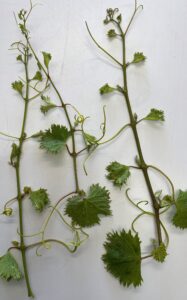11 September 2024
Phenoxy herbicide spray drift onto vineyards is a relatively common occurrence, resulting in grapevine damage and potential residue issues.
This agrochemical update provides a reminder of the damage to look out for, and who to contact to report spray drift damage to grapevines, or potential cases of off-label herbicide application.
Damage to look out for
Grapevines are sensitive to phenoxy herbicides such as 2,4-D. Exposure can lead to adverse effects on yield, vegetative growth, vine health and overall fruit quality.
Typically, symptoms of 2,4-D exposure in grapevines are first noted as distorted leaf tissue (Figure 1); observed mostly in young developing leaves. Other symptoms include tendril necrosis, zig-zag shoots and curled leaves. Symptom severity is generally related to a range of factors including chemical dose strength, timing and number of exposure events, as well as vine age. Grapevine yield has been shown to be impacted both in the season of exposure and the season thereafter, with respect to bunch number and bunch size.

Figure 1. Distorted grapevine leaf tissue from 2,4-D herbicide spray drift. Image courtesy of Anna Baum, Clare Valley Wine & Grape Association.
For assistance in identifying the cause of spray drift based on vine damage symptoms, refer to this Rossouw (2018) report.
Reporting spray drift incidents
Agricultural chemical users have a legal obligation to make sure chemicals are applied according to label directions and products stay within the target area.
If vine or crop damage occurs as a result of off-target spray drift from outside your property; or you become aware of non-compliant chemical use, this should be immediately reported to the appropriate authority for further investigation.
Responsibility for addressing incidents of off-target spray drift sits with each state and territory government. Refer below for contact details for the relevant organisation. Further details are also provided on the Australian Pesticides and Veterinary Medicines Authority website. If you are in any doubt, please contact the AWRI helpdesk for assistance.
Reporting cases of spray drift
NSW
NSW Environment Protection Authority
Phone: 131 555 for the EPA’s Environmental line
Web: Preventing pesticide misuse (nsw.gov.au)
QLD
Biosecurity Queensland
Phone: 13 25 23
Web: Reporting chemical spray drift | Business Queensland
SA
Biosecurity SA Agricultural and Veterinary Chemicals Hotline
Phone: 1300 799 684
Email: pirsa.ruralchemicals@sa.gov.au
Web: Reporting chemical misuse – PIRSA
TAS
AgVet Chemicals Program
Phone: 03 6777 2133
Email: agvetchemicals@nre.tas.gov.au
Web: Spray Drift and Reporting Incidents | Department of Natural Resources and Environment Tasmania (nre.tas.gov.au)
VIC
Agriculture Victoria
Phone: 136 186
WA
WA Department of Health
Phone: 08 9222 4222
Testing vines, grapes or wine for spray drift residues
Depending on the circumstances of the spray drift incident and grape purchaser requirements, you may consider residue testing of foliage, fruit or wine. Contact the Affinity Labs team on (08) 8313 0444 or via email at customerservice@affinitylabs.com.au to discuss.
For further information about spray drift or any other grape and wine technical issues, please contact the AWRI helpdesk on (08) 8313 6600 or email helpdesk@awri.com.au.
Acknowledgements
The AWRI’s eBulletin is supported by Wine Australia, with levies from Australia’s grapegrowers and winemakers and matching funds from the Australian Government. The AWRI is a member of the Wine Innovation Cluster in Adelaide, South Australia.

